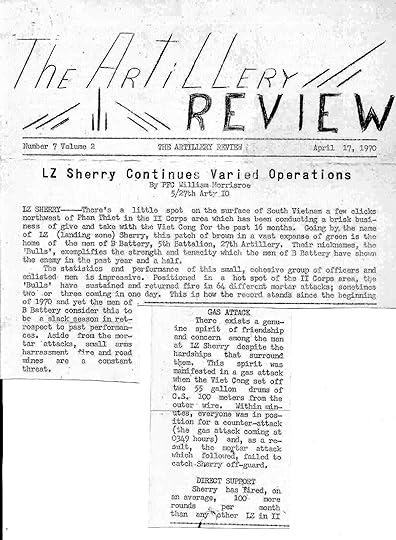Chuck Heindrichs – Battery Commander – Part One
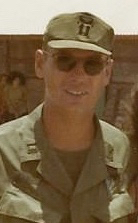 Captain Chuck Heindrichs
Captain Chuck Heindrichs
West Point ’65
Battery Commander, January – August 1970
Captain Chuck Heindrichs came to LZ Sherry in January 1970 on his second tour in Vietnam. His first Vietnam tour was in 1966: leading a platoon of 155 mm self-propelled artillery attached to an Australian battalion, and then participating in Operation Junction City, one of the largest operations of the Vietnam war. Like many officers returning to Vietnam on a second tour he insisted on a combat command over a desk job. His was not a quiet time at Sherry, best described in the First Field Force newspaper three months into his command.
To appreciate Chuck’s command at Sherry we begin with his early career and first tour in Vietnam … in his own words.
The Road to Vietnam
The scenario for my class out of West Point was you went to airborne school and Ranger school, and then you went to the officers basic course for your branch training, which in my case would have been artillery at Ft. Sill. Our class, and we may have been the first, skipped the basic course and learned artillery on the fly. My first assignment out of Ranger school was to Ft. Carson, Colorado assigned to the 1st/19th Artillery, whose mission was to conduct basic training for six hundred young kids in how to shoot a rifle, wear a uniform, etc. I did that for a couple months, and did not learn much artillery in the process.
All of a sudden I learn about a 155 mm self-propelled howitzer unit on post that has alert orders for Vietnam (2nd/35th). Thinking it’s only a matter of time before I’m going to Vietnam anyway, I’ll just volunteer for that unit and maybe get my pick of assignments. But you’re a 2nd lieutenant, you’re probably going to be a forward observer no matter what.
This was going to be the first self-propelled artillery unit going into Vietnam, and we spent maybe three months putting the unit together. At that point the Army had gotten over its shyness about using armor and tracked vehicles in general. They had sent an armored unit or two over there and found out that tanks, armored personnel carriers and other tracked vehicles could get around just fine.
The Army at that time did not have jungle equipment, jungle boots, jungle fatigues or even OD olive drab underwear. There were about five hundred guys going over. They and their wives hit the local Laundromats to dye their white Army-issue underwear green. They overwhelmed the Laundromats dying t-shirts, drawers, socks and handkerchiefs. All this green dye left a residue for the next unsuspecting civilian coming in to do their regular laundry, surprised to see it coming out a light green.
We left Ft. Carson in June 1966. All the equipment went on trains headed for port, while the unit itself went up to Spokane and boarded a troop ship. I did not leave with the unit because I had gotten strep throat and had a three day delay. Rather than trying to catch me up with the troop ship they just threw me on a plane with the advance party, which left a week and a half later.
We flew on a C-130 for what felt like a week, island hopping all the way over. It was the most uncomfortable thing, because it didn’t have regular seats. It just had the flop down canvas seats on the side. Twice leaving Guam the plane was in the air for an hour, sprung an oil leak, and had to fly back and sit on the runway for repairs. Long story short, we get there and we are assigned to Second Field Force, which at that time was at Ben Hoa. They tell our battalion commander that they are going to detach one of his batteries and assign it to the Australians. I was assigned to A Battery, and as luck would have it, they sat me down and said it’s your battery that’s going to work through with the Australians. Learn all you can about their operation, figure out how to talk to them and so forth.
Chuck learned almost no artillery pushing troops through basic training at Ft. Carson . It was with the Australians that he would become a true artillery officer.
Little Toys To Big Toys
The Australians had come over with this little L5 pack howitzer, shooting the snot out of this thing and wrecking them because they were not very big. They looked like little toys. All of a sudden they’ve got these big 155 mm self-propelled coming in. They’d never used them, never even seen them, and it took a while for them to get used to the fact that these guns were used in a direct support mode. They were still leery of shooting that big a round that close to troops. It took time for them to get used to us, and we to them, and how to communicate over the radios. They also had a New Zealand contingent there, a battalion of infantry and an artillery battery.
Gordon Steinbrook, a forward observer attached to the First Australian, wrote a book based largely on correspondence with his wife. In it he says,
“Our battery fire direction officer was Lt. Chuck Heindrichs, a West Point Graduate. Chuck was loud, obnoxious, and at times overbearing. Though he had no formal artillery gunnery schooling, Chuck taught himself, and with the help of the FDC section chief he molded the Fire Direction Center into a capable organization. At handling troops, Chuck was a wizard. He could be loud and harsh one moment and the next minute put his arm around a soldier and say, ‘OK, now let’s sort this problem out.’ Chuck had a gift for keeping morale high. Chuck played the guitar, a talent all of us were to appreciate in the coming months.”
Allies and Mates: An American Soldier with the Australians and New Zealanders in Vietnam, 1966 – 1967, by Gordon L. Steinbrook
All pictures below were taken by Chuck and appear in Allies and Mates
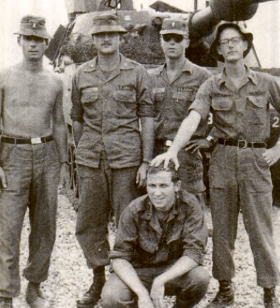 Lt. Heindrichs at far left, next to “Gordy”
Lt. Heindrichs at far left, next to “Gordy”
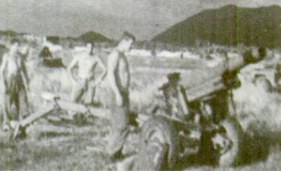 Aussie L5 Howitzer
Aussie L5 Howitzer
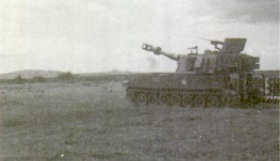 A Battery 155 mm howitzer
A Battery 155 mm howitzer
There was a rule in those days that if you had a hundred and twenty days or more of service left you went to Vietnam, even if it meant in four months you would be going home. Our battery XO (Executive Officer) had 138 days left when he left Ft. Carson with the main body. By the time the unit shipped by rail to port, spent thirty-two days on the ocean, and finally got to the First Australian Taskforce, he only had about sixty days of service left.
Since I went with the advance party I got to the First Australian well before him, and as a result I had gotten integrated into their tactical operations center. I learned their radio call sign system, I introduced them to the 155 mm self-propelled howitzer, I worked with their infantry guys to let them know what was coming. So I became the designated replacement for him when he left Vietnam. I went out with the infantry showing these guys what the 155 guns could do, and helped them experience calling for fire, let them get used to the size and magnitude of rounds going off relatively close to them. To be honest, it was as much a learning experience for me as for them, a learn-on-the-fly for a young officer in Vietnam.
The Wrong Red Reflector
We pulled out of the Australian unit to participate in Operation Junction City, an awfully big operation involving something like forty battalions up into Tay Ninh province and War Zone Charlie (near the Cambodian border).
Operation Junction City was an 82-day airborne operation conducted by United States and South Vietnam forces beginning on 22 February 1967. It was the largest U.S. airborne operation since WWII and the only major airborne operation of the Vietnam War. It was one of the largest U.S. operations of the war, involving the equivalent of nearly three U.S. divisions totaling around twenty thousand troops. The aim of the engagement was to locate the elusive ‘headquarters’ of the Communist uprising in South Vietnam. According to U.S. analysts such a headquarters was almost a “mini-Pentagon,” complete with typists, file cabinets and staff workers. The actual headquarters, revealed after the war by VC archives, was a small and mobile group of people sheltering in ad hoc facilities.
It always terrified me as the battery XO that somebody somehow would make a mistake. I used to walk around all night just checking and talking to the crews. I remember one night seeing the guns silhouetted against the sky and noticing one of them absolutely did not look right. I walked up to the gun sergeant and said, “Let’s look at re-laying this gun because it just does not look right to me.” And sure enough when we checked the gun was aimed in the wrong direction. And here’s how that happened. When a gun is laid using an aiming circle there are two stakes placed at 50 feet and 100 feet away – one with a green reflector and one with a red reflector. Looking through the site of the gun, when the green and red reflectors line up, along what is called the Near Far Line, you know the gun is aligned correctly and parallel to all the other guns. You then put out your permanent aiming stakes used in adjusting the direction of the gun for fire missions.
When the sergeant looked through the sight along the Near Far Line he said, “You’re right.” Then I looked through the site and said, “Wait a minute.” We walked out in front of the gun and discovered he had lined up the gun according to correct procedure, but instead of using the red reflector stake on the Near Far Line, he had used a reflector on the back of a truck.

